Corporations with complex, high-consideration sales are often accused of 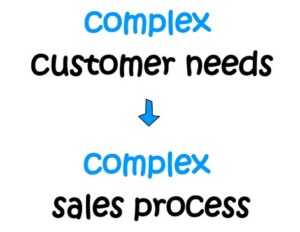 focusing on the short-term, which is inevitably reflected in their demand generation or campaign strategy. This generally means that marketing and sales are not aligned and operating to some degree as silos. With short-term horizons, the campaign communications focus tends to be on sales driven, tactical programs designed to seek out “hot leads”.
focusing on the short-term, which is inevitably reflected in their demand generation or campaign strategy. This generally means that marketing and sales are not aligned and operating to some degree as silos. With short-term horizons, the campaign communications focus tends to be on sales driven, tactical programs designed to seek out “hot leads”.
In the highly competitive, complex B2B sales world with longer sales cycles, this is not fully sustainable. There is a typically a sales team or committees of savvy buyers. A short term focus may eke out some leads, but what about the other leads who may with some nurturing turn out to be qualified opportunities — but not yet “sales-ready.” The modern buyer knows your product or service from what is readily available on the web and related sources and will be considering any number of options before making a decision.
Studies show that 50% of leads are qualified but aren’t immediately ready to buy something from you [Source: Gleanster Research]. With lead nurturing however, you can bring those leads through your sales funnel and garner 4-10 times the response rate compared to a regular email blast while doing it [Source: SilverPop/DemandGen Report].
So where do you start?
The answer it to architect campaign programs that build a pipeline of qualified leads across the customer lifecycle.
Complex Sales Campaign Design
Architecting a sales campaign involves lots of moving parts and requires a thoughtful, orchestrated process. To address this, we developed a Closed Loop Marketing Architecture™ (CLMA). CLMA is an technology-enabled, data-driven process that uses customer analytics to plan and run campaigns, capture and qualify leads, convert leads into sales and measure marketing and sales effectiveness.
Illustrative Case Study
- Overarching strategy informed by insights, analytics and trends:
The firm’s strategy was to target an untapped audience for its products — a ‘B2B’ intermediary audience in the U.S — leveraging thought leadership content that is educational and evaluative and that helped the client’s core business with using timely insights and research. - Overall program/campaigns concept:
We started small. The first campaign involved development of a personalized bi-monthly newsletter of sophisticated, accessible, and convenient ‘must read’ information. There were four content assets on differing topics excerpted with an image and linked to the company website. One of the four was “client-only” and was therefore ‘gated’ behind a form. Campaign off-shoots involved lead nurturing campaigns and inbound subscription campaigns. - Objectives:
The major objective was to build customer insights on preferences and build qualified leads. Lead scores, progressive profiles informed lead qualification by using marketing automation to capture behaviors and nurture leads across the customer lifecycle. Lead scores increase, for example, when a prospect (1) clicks on a link, indicating interest is a particular article/topic, (2) clicks on the premium asset link and answers one or two progressive profiling questions to gain access to the gated content (3) opts-in to the inbound newsletter subscription campaign. - Channels:
The channels for this initial campaign was both outbound via email and inbound via organic web site visits, blog posts and social media. A topic-specific campaign program targeted a subset of leads (opt-ins, clicks, premium asset conversions etc.), and additionally involved paid media (advertising). - Branding/Positioning:
The campaign branding aligned with the company’s re-launched thought leadership website and was positioned as valuable news and insights to help them engage and enhance the relationship with their clients. - Target Audience:
The program was aimed to attract clients who were seeking to differentiate by aligning with the company’s philosophy and principles, and ultimately through a more valued relationship, purchase it’s products - Differentiated Content:
Three of the four segments of the newsletter were repackaged from existing, “best of” web content in a bi-monthly compendium of cogent segments/excerpts with images and links to read/learn more. The fourth segment was exclusive or premium content that was actionable and gated by a form.
Follow-on lead nurturing campaign content responded to particular interests and was mapped to the customer life cycle/ funnel stages.
Derivative Content was created by stretching the lifespan of core content into more channels and forms including social media, blogs videos and podcasts.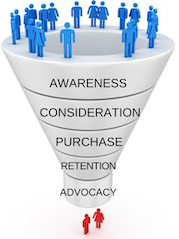
It is important to match marketing campaign content with the customer lifecycle – the steps or journey a customer goes through when considering, purchasing, using, and maintaining loyalty to a product or service. - Experience/Engagement
Iterative testing and refinement assured a quality, accessible and mobile responsive experience for all campaigns – newsletter, nurture campaigns, forms for premium content, call to action buttons and landing pages for inbound campaigns.
Applying best practices: introductory messaging was brief, actionable and scannable; key content or offer was above the fold; A/B testing was used to test different email subject lines and website and all campaign components (emails, landing pages, etc.) were mobile responsive. - Technology
The Closed Loop Marketing Architecture encompasses an integrated set of technologies including; Marketing Automation, Salesforce Automation, Data Management and Business Intelligence. Download the CLMA. - Conversions
With each successive campaign, customer intents, context, actions and behaviors are captured across all channel touch points.
Lead responses are orchestrated throughout the marketing-sales funnel by responding to behaviors and key performance indicators.
“Sales ready” leads are passed on to sales as marketing continues to generate and nurture both short and long-term opportunities.
Summary
Complex sales campaigns should be continuous and insight driven. The Closed Loop Marketing Architecture™ (CLMA) — is the blueprint we use for campaign design and execution to capture new customer accounts and deliver lifetime value. Learn more.

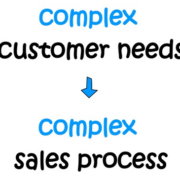
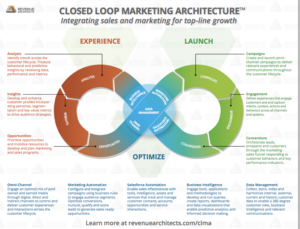

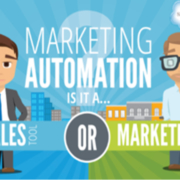





Leave a Reply
Want to join the discussion?Feel free to contribute!